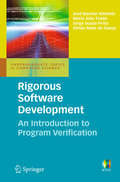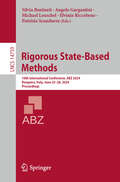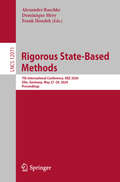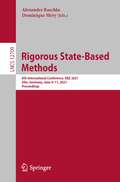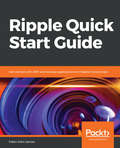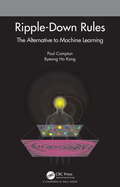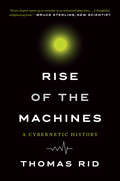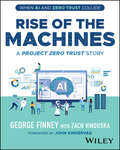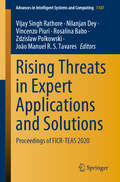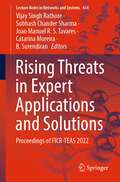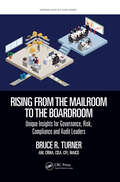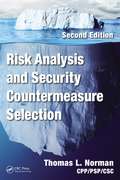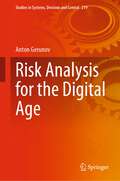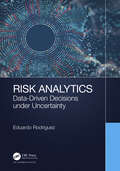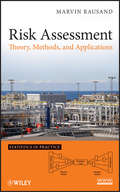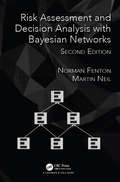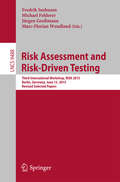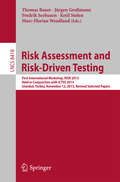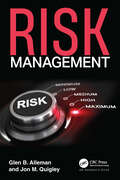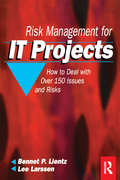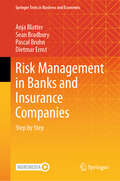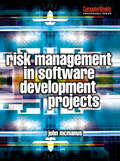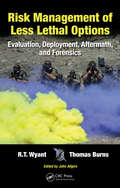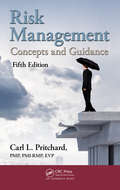- Table View
- List View
Rigorous Software Development
by Maria João Frade Jorge Sousa Pinto José Bacelar Almeida Simão Melo de SousaThe use of mathematical methods in the development of software is essential when reliable systems are sought; in particular they are now strongly recommended by the official norms adopted in the production of critical software. Program Verification is the area of computer science that studies mathematical methods for checking that a program conforms to its specification. This text is a self-contained introduction to program verification using logic-based methods, presented in the broader context of formal methods for software engineering. The idea of specifying the behaviour of individual software components by attaching contracts to them is now a widely followed approach in program development, which has given rise notably to the development of a number of behavioural interface specification languages and program verification tools. A foundation for the static verification of programs based on contract-annotated routines is laid out in the book. These can be independently verified, which provides a modular approach to the verification of software. The text assumes only basic knowledge of standard mathematical concepts that should be familiar to any computer science student. It includes a self-contained introduction to propositional logic and first-order reasoning with theories, followed by a study of program verification that combines theoretical and practical aspects - from a program logic (a variant of Hoare logic for programs containing user-provided annotations) to the use of a realistic tool for the verification of C programs (annotated using the ACSL specification language), through the generation of verification conditions and the static verification of runtime errors.
Rigorous State-Based Methods: 10th International Conference, ABZ 2024, Bergamo, Italy, June 25–28, 2024, Proceedings (Lecture Notes in Computer Science #14759)
by Patrizia Scandurra Elvinia Riccobene Michael Leuschel Angelo Gargantini Silvia BonfantiThis book constitutes the refereed proceedings of the 10th International Conference on Rigorous State-Based Methods, ABZ 2024, held in Bergamo, Italy, during June 25–28, 2024. The 29 papers included in this volume were carefully reviewed and selected from 47 submissions. They were organized in topical sections as follows: research papers; short research papers; case study; doctoral symposium.
Rigorous State-Based Methods: 7th International Conference, ABZ 2020, Ulm, Germany, May 27–29, 2020, Proceedings (Lecture Notes in Computer Science #12071)
by Alexander Raschke Dominique Méry Frank HoudekThis book constitutes the refereed proceedings of the 7th International Conference on Rigorous State-Based Methods, ABZ 2020, which was due to be held in Ulm, Germany, in May 2020. The conference was cancelled due to the COVID-19 pandemic. The 12 full papers and 9 short papers were carefully reviewed and selected from 61 submissions. They are presented in this volume together with 2 invited papers, 6 PhD-Symposium-contributions, as well as the case study and 6 accepted papers outlining solutions to it. The papers are organized in the following sections: keynotes and invited papers; regular research articles; short articles; articles contributing to the case study; short articles of the PhD-symposium (work in progress).
Rigorous State-Based Methods: 8th International Conference, ABZ 2021, Ulm, Germany, June 9–11, 2021, Proceedings (Lecture Notes in Computer Science #12709)
by Alexander Raschke Dominique MéryThis book constitutes the proceedings of the 8th International Conference on Rigorous State-Based Methods, ABZ 2021, which was planned to take place in Ulm, Germany, during June 6-11, 2021. The conference changed to an online format due to the COVID-19 pandemic. The 6 full and 8 short papers included in this volume were carefully reviewed and selected from 18 submissions. The proceedings also include 3 PhD symposium contributions. They deal with state-based and machine-based formal methods, mainly Abstract State Machines (ASM), Alloy, B, TLA+, VDM, and Z.
Ripple Quick Start Guide: Get started with XRP and develop applications on Ripple's blockchain
by Febin John JamesLearn to work with XRP and build applications on Ripple's blockchain Key Features Learn to use Ripple's decentralized system for transfering digital assets globally A simpilfied and shortened learning curve to understand the Ripple innovation and Blockchain Takes a hands-on approach to work with XRP – Ripple's native currency Book Description This book starts by giving you an understanding of the basics of blockchain and the Ripple protocol. You will then get some hands-on experience of working with XRP. You will learn how to set up a Ripple wallet and see how seamlessly you can transfer money abroad. You will learn about different types of wallets through which you can store and transact XRP, along with the security precautions you need to take to keep your money safe. Since Ripple is currency agnostic, it can enable the transfer of value in USD, EUR, and any other currency. You can even transfer digital assets using Ripple. You will see how you can pay an international merchant with their own native currency and how Ripple can exchange it on the ?y. Once you understand the applications of Ripple, you will learn how to create a conditionally-held escrow using the Ripple API, and how to send and cash checks. Finally, you will also understand the common misconceptions people have about Ripple and discover the potential risks you must consider before making investment decisions. By the end of this book, you will have a solid foundation for working with Ripple's blockchain. Using it, you will be able to solve problems caused by traditional systems in your respective industry. What you will learn Understand the fundamentals of blockchain and Ripple Learn how to choose a Ripple wallet Set up a Ripple wallet to send and receive XRP Learn how to protect your XRP Understand the applications of Ripple Learn how to work with the Ripple API Learn how to build applications on check and escrow features of Ripple Who this book is for This book is for anyone interested in getting their hands on Ripple technology and learn where it can be used to gain competitive advantages in their respective fields. For most parts of the book, you need not have any pre-requisite knowledge. However, you need to have basic background of JavaScript to write an escrow.
Ripple-Down Rules: The Alternative to Machine Learning
by Byeong Ho Kang Paul Compton"In this era of deep learning, where is our deeper understanding of AI? The answer is, here, in this book. Compton and Kang's ideas are a ‘must-read’ for anyone working with AI. Based on examples of real-world applications, they show us a better way to use AI. If your AI models are confusing to understand and hard to maintain, then this book is for you." Tim Menzies, Professor, North Carolina State University Machine learning algorithms hold extraordinary promise, but the reality is that their success depends entirely on the suitability of the data available. This book is about Ripple-Down Rules (RDR), an alternative manual technique for rapidly building AI systems. With a human in the loop, RDR is much better able to deal with the limitations of the data. Ripple-Down Rules: The Alternative to Machine Learning starts by reviewing the problems with data quality and the problems with conventional approaches to incorporating expert human knowledge into AI systems. It suggests that problems with knowledge acquisition arise because of mistaken philosophical assumptions about knowledge. It argues people never really explain how they reach a conclusion, rather they justify their conclusion by differentiating between cases in a context. RDR is based on this more situated understanding of knowledge. The central features of a RDR approach are explained, and detailed worked examples are presented for different types of RDR, based on freely available software developed for this book. The examples ensure developers have a clear idea of the simple yet counter-intuitive RDR algorithms to easily build their own RDR systems. It has been proven in industrial applications that it takes only a minute or two per rule to build RDR systems with perhaps thousands of rules. The industrial uses of RDR have ranged from medical diagnosis through data cleansing to chatbots in cars. RDR can be used on its own or to improve the performance of machine learning or other methods.
Rise of the Machines: A Cybernetic History
by Thomas RidA sweeping history of our deep entanglement with technology. As lives offline and online merge even more, it's easy to forget how we got here. Rise of the Machines reclaims the spectacular story of cybernetics, a control theory of man and machine. In a history that unpacks one of the twentieth century's pivotal ideas, Thomas Rid delivers a thought-provoking portrait of our technology-enraptured era. Springing from the febrile mind of mathematician Norbert Wiener amid the devastation of World War II, the cybernetic vision underpinned a host of seductive myths about the future of machines. This vision would radically transform the postwar world, ushering in sweeping cultural change. From the Cold War's monumental SAGE bomber defense system to enhanced humans, Wiener's scheme turned computers from machines of assured destruction into engines of brilliant utopias. Cybernetics triggered blissful cults, the Whole Earth Catalog, and feminist manifestos, just as it fueled martial gizmos and the air force's foray into virtual space. As Rid shows, cybernetics proved a powerful tool for two competing factions--those who sought to make a better world and those who sought to control the one at hand. In the Bay Area, techno-libertarians embraced networked machines as the portal to a new electronic frontier: a peaceful, open space of freedom. In Washington, DC, cyberspace provided the perfect theater for dominance and war. Meanwhile the future arrived secretly in 1996, with Moonlight Maze, dawn of a new age of digital state-on-state espionage. That "first cyberwar," as Rid reveals in a blow-by-blow account, went on for years--and indeed has never stopped. In our long-promised cybernetic future, the line between utopia and dystopia continues to be disturbingly thin. Drawing on new sources and interviews with hippies, anarchists, sleuths, and spies, Rise of the Machines offers an unparalleled perspective into our anxious embrace of technology and today's clash of digital privacy and security.
Rise of the Machines: A Project Zero Trust Story
by George FinneyExpert guide to create Zero Trust digital environments in an AI-everywhere landscape Rise of the Machines: A Project Zero Trust Story is a continuation of the 2023 bestseller Project Zero Trust, picking up where the first book left off and addressing issues not covered in the first installment: artificial intelligence, mergers and acquisitions, antivirus, business continuity, and remote work. Artificial Intelligence is the dominant issue discussed in every chapter, providing a case-study-based approach to applying zero trust principles to all the various aspects of artificial intelligence, from MLOps, used by security teams, to use of GPTs, chatbots, and adversarial AI. AI transforms technology by enabling unprecedented automation and decision-making, but securing it with a Zero Trust approach is essential because AI inherently relies on trusted data and systems, making it a target for manipulation. The book also includes discussion around regulatory issues and the alignment of regulation around Zero Trust practices. Written by George Finney, 2024 recipient of the Baldrige Foundation Leadership Award for Cybersecurity and recognized as one of the top 100 CISOs in the world in 2022, this book provides key insights on: Appling the four Principles of Zero Trust to AI: Focusing On Business Outcomes, Designing From The Inside Out, Determining Who Or What Needs Access, and Inspecting And Logging All Traffic Using the five steps of the Zero Trust Methodology to secure AI technologies: Defining Your Protect Surface, Mapping Transaction Flows, Architecting Your Environment, Creating Zero Trust Policies, and Monitoring and Maintaining Your Environment The evolution of Adversarial AI to scale attacks and how security operations teams can integrate into the Zero Trust strategy to use AI to accelerate defense Rise of the Machines: A Project Zero Trust Story is a timely, essential read for all IT professionals across industries, including network engineers, system administrators, and cloud architects.
Rising Threats in Expert Applications and Solutions: Proceedings of FICR-TEAS 2020 (Advances in Intelligent Systems and Computing #1187)
by Vincenzo Piuri João Manuel R. S. Tavares Nilanjan Dey Rosalina Babo Vijay Singh Rathore Zdzislaw PolkowskiThis book presents high-quality, peer-reviewed papers from the FICR International Conference on Rising Threats in Expert Applications and Solutions 2020, held at IIS University Jaipur, Rajasthan, India, on January 17–19, 2020. Featuring innovative ideas from researchers, academics, industry professionals and students, the book covers a variety of topics, including expert applications and artificial intelligence/machine learning; advanced web technologies, like IoT, big data, and cloud computing in expert applications; information and cybersecurity threats and solutions; multimedia applications in forensics, security and intelligence; advances in app development; management practices for expert applications; and social and ethical aspects of expert applications in applied sciences.
Rising Threats in Expert Applications and Solutions: Proceedings of FICR-TEAS 2022 (Lecture Notes in Networks and Systems #434)
by Vijay Singh Rathore Subhash Chander Sharma Joao Manuel R. S. Tavares Catarina Moreira B. SurendiranThe book presents high-quality, peer-reviewed papers from the FICR International Conference on Rising Threats in Expert Applications and Solutions 2022 organized by IIS (Deemed to be University), Jaipur, Rajasthan, India, during January 7–8, 2022. The volume is a collection of innovative ideas from researchers, scientists, academicians, industry professionals, and students. The book covers a variety of topics, such as expert applications and artificial intelligence/machine learning; advance web technologies such as IoT, big data, cloud computing in expert applications; information and cyber security threats and solutions, multimedia applications in forensics, security and intelligence; advancements in app development; management practices for expert applications; and social and ethical aspects in expert applications through applied sciences.
Rising from the Mailroom to the Boardroom: Unique Insights for Governance, Risk, Compliance and Audit Leaders (Internal Audit and IT Audit)
by Bruce R. TurnerBoards and business leaders expect their key advisors to deliver fresh insights, and increasingly expect them to demonstrate foresight. To achieve what is expected, it is crucial to understand the dynamics of conversations in the boardroom and around the audit committee table. This book provides those unique perspectives. The journey from the ‘mailroom to the boardroom’ follows the story of a young banker who moved into the internal auditing profession as part of the ‘new breed’, then rose through the ranks into senior leadership and chief audit executive roles, before assuming audit committee and board roles that had an immense influence on governance, risk, compliance, and audit professionals. Success does not always follow a smooth and uneventful trajectory, and this story reflects insights from both the ups and the downs of the journey. Each chapter shares insights, better practices, case studies, practical examples, and real-life challenges and draws them together into 101 building blocks, each one providing crucial career-long learnings. The storytelling provides insights to people at all levels on the importance of positioning oneself to step into leadership roles, helps them understand how to evaluate and pursue potential career growth opportunities, provides tips on how to holistically manage and advance their career, and inspires higher-level thinking that enhances governance, risk, compliance and audit practices.
Risk Analysis and Security Countermeasure Selection
by Thomas L. Norman CPP/PSP/CSCThis new edition of Risk Analysis and Security Countermeasure Selection presents updated case studies and introduces existing and new methodologies and technologies for addressing existing and future threats. It covers risk analysis methodologies approved by the U.S. Department of Homeland Security and shows how to apply them to other organizations
Risk Analysis for the Digital Age (Studies in Systems, Decision and Control #219)
by Anton GerunovThis book presents a foray into the fascinating process of risk management, beginning from classical methods and approaches to understanding risk all the way into cutting-age thinking. Risk management by necessity must lie at the heart of governing our ever more complex digital societies. New phenomena and activities necessitate a new look at how individuals, firms, and states manage the uncertainty they must operate in. Initial chapters provide an introduction to traditional methods and show how they can be built upon to better understand the workings of the modern economy. Later chapters review digital activities and assets like cryptocurrencies showing how such emergent risks can be conceptualized better. Network theory figures prominently and the book demonstrates how it can be used to gauge the risk in the digital sectors of the economy. Predicting the unpredictable black swan events is also discussed in view of a wider adoption of economic simulations. The journey concludes by looking at how individuals perceive risk and make decisions as they operate in a virtual social network. This book interests the academic audience, but it also features insights and novel research results that are relevant for practitioners and policymakers.
Risk Analytics: Data-Driven Decisions under Uncertainty
by Eduardo RodriguezThe 2022 World Economic Forum surveyed 1,000 experts and leaders who indicated their risk perception that the earth’s conditions for humans are a main concern in the next 10 years. This means environmental risks are a priority to study in a formal way. At the same time, innovation risks are present in theminds of leaders, newknowledge brings new risk, and the adaptation and adoption of risk knowledge is required to better understand the causes and effects can have on technological risks. These opportunities require not only adopting new ways of managing and controlling emerging processes for society and business, but also adapting organizations to changes and managing newrisks. Risk Analytics: Data-Driven Decisions Under Uncertainty introduces a way to analyze and design a risk analytics system (RAS) that integrates multiple approaches to risk analytics to deal with diverse types of data and problems. A risk analytics system is a hybrid system where human and artificial intelligence interact with a data gathering and selection process that uses multiple sources to the delivery of guidelines to make decisions that include humans and machines. The RAS system is an integration of components, such as data architecture with diverse data, and a risk analytics process and modeling process to obtain knowledge and then determine actions through the new knowledge that was obtained. The use of data analytics is not only connected to risk modeling and its implementation, but also to the development of the actionable knowledge that can be represented by text in documents to define and share explicit knowledge and guidelines in the organization for strategy implementation. This book moves from a review of data to the concepts of a RAS. It reviews RAS system components required to support the creation of competitive advantage in organizations through risk analytics. Written for executives, analytics professionals, risk management professionals, strategy professionals, and postgraduate students, this book shows a way to implement the analytics process to develop a risk management practice that creates an adaptive competitive advantage under uncertainty.
Risk Assessment
by Marvin RausandAn introduction to risk assessment that utilizes key theory and state-of-the-art applications With its balanced coverage of theory and applications along with standards and regulations, Risk Assessment: Theory, Methods, and Applications serves as a comprehensive introduction to the topic. The book serves as a practical guide to current risk analysis and risk assessment, emphasizing the possibility of sudden, major accidents across various areas of practice from machinery and manufacturing processes to nuclear power plants and transportation systems.The author applies a uniform framework to the discussion of each method, setting forth clear objectives and descriptions, while also shedding light on applications, essential resources, and advantages and disadvantages. Following an introduction that provides an overview of risk assessment, the book is organized into two sections that outline key theory, methods, and applications.Introduction to Risk Assessment defines key concepts and details the steps of a thorough risk assessment along with the necessary quantitative risk measures. Chapters outline the overall risk assessment process, and a discussion of accident models and accident causation offers readers new insights into how and why accidents occur to help them make better assessments.Risk Assessment Methods and Applications carefully describes the most relevant methods for risk assessment, including preliminary hazard analysis, HAZOP, fault tree analysis, and event tree analysis. Here, each method is accompanied by a self-contained description as well as workflow diagrams and worksheets that illustrate the use of discussed techniques. Important problem areas in risk assessment, such as barriers and barrier analysis, human errors, and human reliability, are discussed along with uncertainty and sensitivity analysis.Each chapter concludes with a listing of resources for further study of the topic, and detailed appendices outline main results from probability and statistics, related formulas, and a listing of key terms used in risk assessment. A related website features problems that allow readers to test their comprehension of the presented material and supplemental slides to facilitate the learning process.Risk Assessment is an excellent book for courses on risk analysis and risk assessment at the upper-undergraduate and graduate levels. It also serves as a valuable reference for engineers, researchers, consultants, and practitioners who use risk assessment techniques in their everyday work.
Risk Assessment and Decision Analysis with Bayesian Networks
by Norman Fenton Martin NeilSince the first edition of this book published, Bayesian networks have become even more important for applications in a vast array of fields. This second edition includes new material on influence diagrams, learning from data, value of information, cybersecurity, debunking bad statistics, and much more. Focusing on practical real-world problem-solving and model building, as opposed to algorithms and theory, it explains how to incorporate knowledge with data to develop and use (Bayesian) causal models of risk that provide more powerful insights and better decision making than is possible from purely data-driven solutions. Features Provides all tools necessary to build and run realistic Bayesian network models Supplies extensive example models based on real risk assessment problems in a wide range of application domains provided; for example, finance, safety, systems reliability, law, forensics, cybersecurity and more Introduces all necessary mathematics, probability, and statistics as needed Establishes the basics of probability, risk, and building and using Bayesian network models, before going into the detailed applications A dedicated website contains exercises and worked solutions for all chapters along with numerous other resources. The AgenaRisk software contains a model library with executable versions of all of the models in the book. Lecture slides are freely available to accredited academic teachers adopting the book on their course.
Risk Assessment and Risk-Driven Testing
by Fredrik Seehusen Michael Felderer Jürgen Großmann Marc-Florian WendlandThis book constitutes the thoroughly refereed conferenceproceedings of the Third International Workshop on Risk Assessment andRisk-driven Testing, RISK 2015, held in conjunction with the OMG TechnicalMeeting in Berlin, Germany, in June 2015. The revised 8 full papers were carefully reviewed and selectedfrom 12 submissions. This workshop addresses systematic approaches that combinerisk assessment and testing. Also, the workshop was structured into the threesessions namely Risk Assessment, Risk and Development and Security Testing.
Risk Assessment and Risk-Driven Testing
by Thomas Bauer Fredrik Seehusen Jürgen Großmann Marc-Florian Wendland Ketil StølenThis book constitutes the thoroughly refereed conference proceedings of the First International Workshop on Risk Assessment and Risk-driven Testing, RISK 2013, held in conjunction with 25th IFIP International Conference on Testing Software and Systems, ICTSS 2013, in Istanbul, Turkey, in November 2013. The revised full papers were carefully reviewed and selected from 13 submissions. The papers are organized in topical sections on risk analysis, risk modeling and risk-based testing.
Risk Assessment and Risk-Driven Testing: First International Workshop, RISK 2013, Held in Conjunction with ICTSS 2013, Istanbul, Turkey, November 12, 2013. Revised Selected Papers (Lecture Notes in Computer Science #8418)
by Thomas Bauer, Jürgen Großmann, Fredrik Seehusen, Ketil Stølen and Marc-Florian WendlandThis book constitutes the thoroughly refereed conference proceedings of the First International Workshop on Risk Assessment and Risk-driven Testing, RISK 2013, held in conjunction with 25th IFIP International Conference on Testing Software and Systems, ICTSS 2013, in Istanbul, Turkey, in November 2013. The revised full papers were carefully reviewed and selected from 13 submissions. The papers are organized in topical sections on risk analysis, risk modeling and risk-based testing.
Risk Management
by Glen B. Alleman Jon M. QuigleyProject success is an elusive goal in every business or technical domain. Project failure usually results from unhandled risks to the technical, cost, and schedule aspects of the project. There are four primary root causes of project failure. Unrealistic performance expectation, with missing Measures of Effectiveness Unrealistic cost and schedule estimates based on inadequate risk adjusted growth models Inadequate assessment of risk and unmitigated exposure to these risks without proper handling strategies Unanticipated technical issues with alternative plans and solutions to maintain the effectiveness of the project processes and its deliverables Risk Management provides a comprehensive overview of the people, principles, processes, and practices as the fundamental base upon which an effective risk management system resides. However, this does not guarantee effective risk management and successful projects and businesses. The first half of the book describes risk management processes, as well as a delineation between risk and hazards and how these are connected. The second half of the book provides industry examples of the approach to risk management in specific context and with specific approaches and artifacts where applicable.The book focuses on risks created by uncertainty, their identification, and the corrective and preventive actions needed to address these risks to increase the probability of project success. The book’s goal is to provide a context-driven framework, developing a foundation for a rational approach to risk management that makes adaptation to circumstances as easy as possible.
Risk Management for IT Projects
by Bennet Lientz Lee LarssenThe rate of failure of IT projects has remained little changed in survey after survey over the past 15-20 years—over 40-50%. This has happened in spite of new technology, innovative methods and tools, and different management methods. Why does this happen? Why can’t the situation be better? One reason is that many think of each IT effort as unique. In reality many IT projects are very similar at a high, strategic level. Where they differ is in the people and exact events—the detail. If you read the literature or have been in information systems or IT for some time, you have seen the same reasons for failure and the same problems and issues recur again and again. In this book IT Management experts Ben Lientz and Lee Larssen show you how to identify and track the recurring issues leading to failure in IT projects and provide a proven, modern method for addressing them. By following the recommendations in this books readers can significantly reduce the risk of IT failures and increase the rate of success. Benefits of using this approach:• Issues are identified earlier—giving more time for solution and action.• Issues are resolved more consistently since the approach tracks on their repetition.• You get an early warning of problems in IT work—before the budget or schedule fall apart.• Management tends to have more realistic expectations with an awareness of issues.• Users and managers have greater confidence in IT due to the improved handling of issues.• Since the number of issues tends to stabilize in an organization, the IT organization and management get better at detecting, preventing, and dealing with issues over time—cumulative improvement.• Giving attention to issues make users more realistic in their requests and acts to deter requirement changes and scope creep.
Risk Management in Banks and Insurance Companies: Step by Step (Springer Texts in Business and Economics)
by Dietmar Ernst Anja Blatter Sean Bradbury Pascal BruhnThis book shows how modern risk management in banks and insurance companies can be modeled in Excel and Matlab. Readers are provided with all the necessary knowledge and skills in a systematic and structured step-by-step manner. Apart from basic Excel knowledge, no previous knowledge is required. The textbook is divided into five parts. First, the reader learns the basics of analyzing and modeling market risks. Next, the authors introduce and explain the modeling of credit risks and operational risks are quantified by calibrating loss distributions based on expert estimates. Furthermore, individual risk measures are examined in more detail. In order to calculate a risk measure for an overall portfolio to determine the risk capital, the question of the aggregation method is discussed. There are various common concepts for this, which are examined in more detail in the last part of the book.The book is aimed at students of business administration with a focus on financial services. Accompanying the book, readers receive Excel spreadsheets as digital bonus material for practice and application.
Risk Management in Software Development Projects
by John McManusVery few software projects are completed on time, on budget, and to their original specification causing the global IT software industry to lose billions each year in project overruns and reworking software. Research supports that projects usually fail because of management mistakes rather than technical mistakes. Risk Management in Software Development Projects focuses on what the practitioner needs to know about risk in the pursuit of delivering software projects.Risk Management in Software Development Projects will help all practicing IT Project Managers and IT Managers understand:* Key components of the risk management process * Current processes and best practices for software risk identification * Techniques of risk analysis * Risk Planning * Management processes and be able to develop the process for various organizations
Risk Management of Less Lethal Options: Evaluation, Deployment, Aftermath, and Forensics
by R.T. Wyant Thomas BurnsForce used to quell out-of-control demonstrations or detain unruly individuals can result in litigation and bad press for law enforcement agencies. Injury or loss of life can best be avoided if agencies have accurate knowledge and proper training in less lethal options. Risk Management of Less Lethal Options: Evaluation, Deployment, Aftermath, and
Risk Management: Concepts and Guidance, Fifth Edition
by Carl L. Pritchard, PMP, PMI-RMP, EVPThis new edition of Risk Management: Concepts and Guidance supplies a look at risk in light of current information, yet remains grounded in the history of risk practice. Taking a holistic approach, it examines risk as a blend of environmental, programmatic, and situational concerns. Supplying comprehensive coverage of risk management tools, practices, and protocols, the book presents powerful techniques that can enhance organizational risk identification, assessment, and management—all within the project and program environments.Updated to reflect the Project Management Institute’s A Guide to the Project Management Body of Knowledge (PMBOK® Guide), Fifth Edition, this edition is an ideal resource for those seeking Project Management Professional and Risk Management Professional certification. Emphasizing greater clarity on risk practice, this edition maintains a focus on the ability to apply "planned clairvoyance" to peer into the future. The book begins by analyzing the various systems that can be used to apply risk management. It provides a fundamental introduction to the basics associated with particular techniques, clarifying the essential concepts of risk and how they apply in projects. The second part of the book presents the specific techniques necessary to successfully implement the systems described in Part I. The text addresses project risk management from the project manager’s perspective. It adopts PMI’s perspective that risk is both a threat and an opportunity, and it acknowledges that any effective risk management practice must look at the potential positive events that may befall a project, as well as the negatives.Providing coverage of the concepts that many project management texts ignore, such as the risk response matrix and risk models, the book includes appendices filled with additional reference materials and supporting details that simplifying some of the most complex aspects of risk management.
